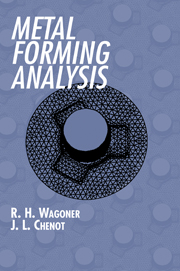Book contents
- Frontmatter
- Dedication
- Contents
- Preface
- Acknowledgments
- 1 Mathematical Background
- 2 Introduction to the Finite-Element Method
- 3 Finite Elements for Large Deformation
- 4 Typical Finite Elements
- 5 Classification of Finite-Element Formulations
- 6 Auxiliary Equations: Contact, Friction, and Incompressibility
- 7 Thermomechanical Principles
- 8 Sheet-Metal Formability Tests
- 9 Steady-State Forming Problems
- 10 Forging Analysis
- 11 Sheet-Forming Analysis
- 12 Recent Research Topics
- Index
5 - Classification of Finite-Element Formulations
Published online by Cambridge University Press: 05 July 2014
- Frontmatter
- Dedication
- Contents
- Preface
- Acknowledgments
- 1 Mathematical Background
- 2 Introduction to the Finite-Element Method
- 3 Finite Elements for Large Deformation
- 4 Typical Finite Elements
- 5 Classification of Finite-Element Formulations
- 6 Auxiliary Equations: Contact, Friction, and Incompressibility
- 7 Thermomechanical Principles
- 8 Sheet-Metal Formability Tests
- 9 Steady-State Forming Problems
- 10 Forging Analysis
- 11 Sheet-Forming Analysis
- 12 Recent Research Topics
- Index
Summary
The finite-element formulation of a given physical problem depends primarily on the nature of the problem and, to some extent, on several numerical choices the scientist decides to make. In this chapter we shall review five different topics, linked to plastic forming, which have a prominent influence on the way the problem will be solved.
First, the explicit and implicit formulations originally corresponded to different problems, distinguished by the deformation rate level, but they are now used for a much larger range of processes.
Second, historically the first attempts to model metal-forming processes by the finite-element method were based on the flow formulation, or the rigid-plastic material model, in which elastic deformation is neglected. Despite an additional cost and a more complex treatment, the elastoplastic approach is more and more often applied to forming problems in engineering.
Third, the Eulerian formulation, when applicable, is very efficient to treat steady-state processes, whereas the updated Lagrangian formulation is the most popular method for the other cases involving large strain.
Fourth, the displacement or velocity approaches were mostly used in the past for practical applications, as they are more economical. However, mixed methods provide an additional flexibility for the finite-element problem formulations, which can result in more satisfactory solutions, both from the mathematical and from the numerical point of view.
Fifth, the problem of time integration of constitutive equations has received considerable attention during the past 20 years, and some progress is still necessary to achieve complete accuracy for any real process.
- Type
- Chapter
- Information
- Metal Forming Analysis , pp. 103 - 131Publisher: Cambridge University PressPrint publication year: 2001

